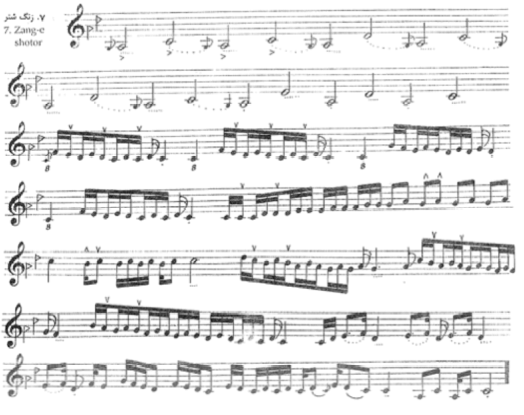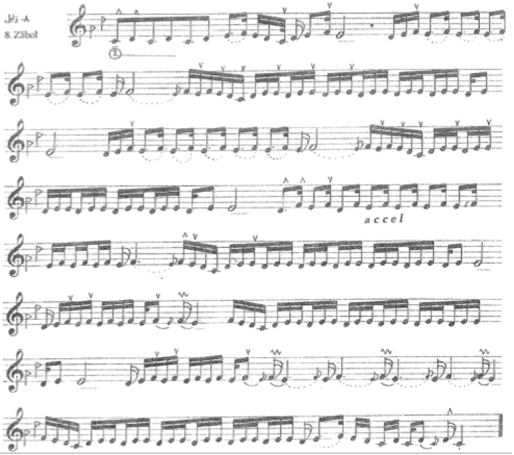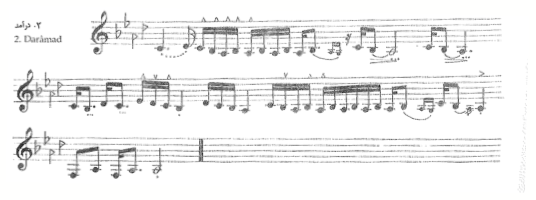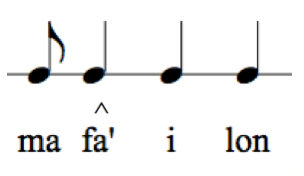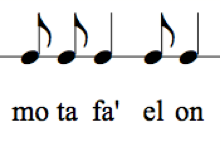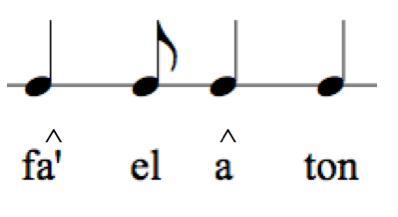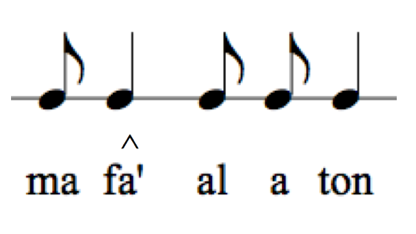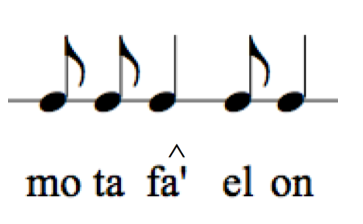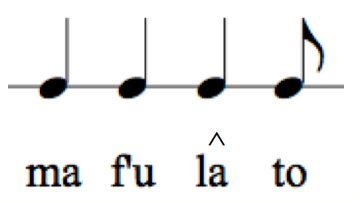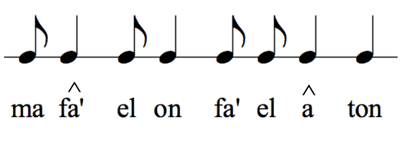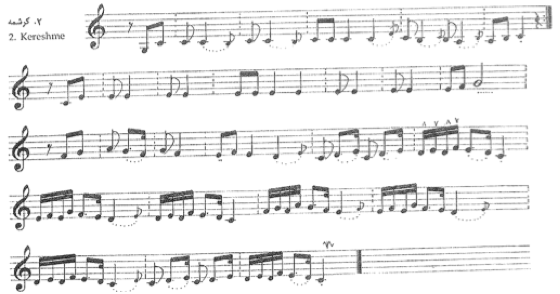Iranian Classical Music, Orientalism and Techniques of Contemporary Composition
Iranian Classical Music, Orientalism and Techniques of Contemporary Composition
1. Introduction
Musicians and artists located in contemporary Western societies have a long history of creative cosmopolitanism: from Henri Matisse’s love affair with Haiti to Claude Debussy’s fascination with Gamelan right up to Paul Simon’s controversial work with South African musicians on his album Graceland. The Western cultural landscape is littered with examples of individuals borrowing creative elements from other cultures, places and contexts. However Said’s seminal work on Orientalism and the field of postcolonial studies more generally have rendered it difficult to view this practice as separate from political struggles of domination and colonialism[1].
As Said makes clear, the discourse of Orientalism, which is heavily intertwined with notions of power, domination and hegemony, allows an unchallengeable Western consciousness to bring the world of the Orient into being. The Orient is constructed as Other, exotic, frozen in time, sexualised and ultimately threatening so that its very characteristics assume the need for colonisation and outside control. Such is the strength of this discursive system that colonised people are forced to draw on these Orientalist representations to substantiate their own existence. Thus, the Occident is able to produce and subjugate the Orient, “politically, sociologically, militarily, ideologically, scientifically and imaginatively” constructing a world which has no textual capability to reply or self-represent[2].
As Locke points out, musical evocations of an exotic East began in earnest in the 17th and 18th centuries and were based around the staging of operas in a vaguely timeless or ‘legendary’ Persia, China, Turkey or India[3]. This tendency increased in the 19th and 20th centuries following the fall of the Ottoman Empire and subsequent colonial ambitions of many Western nations in this part of the world. In opera, this saw the development of Orientalist archetypes including the male tyrant, the Muslim fanatic and the seductive dancing woman; representations which can be found in works by Beethoven (Die Ruinen von Athen), Saint-Saëns (Samson et Dalila) and Strauss (Salome)[4].
Musical Orientalism sees its modern incarnation in the genre of world music[5]. As Feld makes clear, the world music concept reproduces binary notions of Self and Other by delineating the musical cultures of the colonised (termed world music) from those of the colonisers (simply referred to as music)[6]. This process is closely tied to a project of multiculturalism that found particular success in Western nations in the 1980s. As Hesmondhalgh suggests, such cultural and creative ‘borrowing’ takes place within a socio-political landscape in which certain musical producers find themselves at great economic or social disadvantage[7]. This often means that local practitioners find themselves unremunerated for performances that have generated huge profits for recording companies based in the West. Thus, as Sharma points out, the genre of world music traffics in a simultaneous elevation and erasure of Eastern artists such that crucial cultural, temporal and socio-religious contexts of musical forms are erased[8]. In this way, a variety of heterogeneous musical traditions from the Middle East are considered freely interchangeable, reconstructing the notion of a unitary East possessing a homogeneous musical culture.
Said’s concept of Orientalism has not, however, been immune to critique[9]. Heavily indebted to Foucault, Said builds a notion of power constructed entirely in terms of textuality, obscuring material conditions and practices through which power can be resisted or challenged and undertheorising the capability of agents to act within power structures[10]. More recently, scholars have attempted to construct a more variegated and nuanced approach to the experience of living in a postcolonial world. This means not only moving away from binary constructions of power and resistance but also recognising that, while Western domination takes both material and symbolic forms, people have the capacity to respond to these systems through their daily lives in a variety of complex ways.
It is against this backdrop that I undertake a study of the techniques and practices of Iranian classical music with the aim of creating a new composition based on this research. This task presents a major challenge: namely, is it possible for myself, a composer of British-Iranian background who grew up in the UK, to write a piece influenced by a musical culture about which I know very little without trafficking in the notion of an exotic Other? This question is particularly pertinent given that the political climate in which I write sees Iran, Israel and the USA embroiled in a conspiracy of hyperbole, speculation, suspicion and fear[11]. As political pressure mounts against Mahmoud Ahmadinejad’s government, the representation of ordinary Iranians in Western media becomes increasingly one-dimensional, strangling debate and preventing them from articulating their existence outside of discourses related to the current regime. Thus the notion of an Iran that is Other and fearful becomes increasinglly prevalent. In this essay I will explore the tools and techniques of Iranian classical music with the aim of producing my own composition based on this research. My aim is neither to write a pastiche piece nor to create a work that necessarily sounds in any way similar to the music that forms the basis of my research. Rather, I will explore the socio-historical relevance of techniques of Iranian classical music and the creative practices of the musicians involved as a backdrop for a piece firmly based within my own working method. I will struggle with the dynamics of Orientalism with the aim of producing a piece that that does not construct this musical culture as an exotic Other. Through this process I hope to learn more about the work of Iranian classical musicians, produce an innovative piece of work and also consider my own complex relationship to Iran and its culture.
My essay will be constructed as follows: chapter two will give a general explanation of the key tenets of Iranian classical music. Chapter three will consider the role of improvisation, chapter four will explore the importance of microtones and chapter five will examine the function of poetry. In my conclusion I will detail how my research will inform a new composition of my own.
2. Structure of performance
Radif (‘row’) refers to the complete repertoire of Iranian classical music and consists of 400 short pieces (gusheh – ‘corner’) that are taught to a pupil by an ostad (‘master’). For many centuries each ostad was likely to teach their own version of the gusheh built up over many years and thus there was great variation in their content. By the mid-nineteenth century, court musician Ali Akbar Farahan (1810-55) began to formalise the wide range of gusheh into the modern day radif[12].
The modern radif is divided into twelve groups of modes, seven of these are called dastgah and five are referred to as avaz. Each dastgah/avaz and gusheh has its own title referring to a person, a region or particular sentiment or quality of character it is thought to represent[13].
Dastgah-e Shur
Aavaz-e Abuata
Avaz-e Dashti
Avaz-e Bayat-e Tork
Avaz-e Afshari
Dastgah-e Segah
Dastgah-e Chahargah
Dastgah-e Homayun
Avaz-e Bayat-e Esfahan
Dastgah-e Nava
Dastgah-e Mahur
Dastgah-e Rast Panjgah
There is no set structure for performances of Iranian classical music. An example of a commonly used configuration is as follows:
- Pish daramad – a type of ouverture. A rhythmic, instrumental piece that does not use improvisation. A twentieth century invention intended for ensemble playing.
[tube]http://www.youtube.com/watch?v=16HumODps5Y[/tube]
- Daramad – meaning opening, a group of gushehs that always come at the start of the performance.
- Avaz – meaning song. This section includes a vocalist accompanied by one or more instruments. A rubato, unmetered and improvised section, using a range of gusheh.
-
- Oj – a point of climax reached within the avaz. Characterised by higher pitch, louder dynamics and greater forces.
- Tasnif – a composed song with lyrics. A rhythmic piece mostly using slow or moderate tempo. A twentieth century invention, today generally written by well-known composers.
- Return of avaz – exploring further gushehs.
- Chahar mezrab – an instrumental section with a fast tempo. Not longer than two minutes long and intended to display the virtuosity of a solo performer. A largely composed piece that admits some degree of improvisation. Literally meaning ‘four plectrums’ it refers to the rhythmic device used in the piece where a strike of the instrument is followed by four ‘echoes’, the rhythm of which is depicted below:
- Return of avaz.
- Return of Tasnif – a new composed song.
- Foroud – meaning cadence, this represents the conclusion to the performance.
This structure lasts around 30 minutes and remains within one dastgah/avaz throughout.
Dastgah-e Chahargah has around 32 gushehs, each with a range of a tetrachord. The gushehs at the beginning of the series are of a lower pitch, with pitch gradually rising as you move through the series. Within the avaz section, the musician must make a series of decisions which amount to improvisation. Broadly speaking they must decide how many gushehs of that dastgah to play, in which order to play them, how to progress from one to the next and how to embellish or vary their manner of performing each one[18]. The main gushehs of Chahargah are called Zang-e Shotor, Zabol, Muye, Hesar, Mokhalef, Maqlub, Hodi, Pahlavi, Rajaz and Mansuri. Some of these gushehs are transcribed below along with an audio recording:
Gusheh Zang-e Shotor
NB. All examples of notation from Jean During, La Repertoire Modele de la Musique Iranienne (Tehran: Souroush, 1995)
[19].
Gusheh Zabol
[20].
However, it is not just the melodic material of the gushehs that the performer can draw on in a performance context, there are also a number of rhythmic pieces which form the basis of improvisation. These pieces, called zarbi or tekkes, have a relatively stable melodic or rhythmic structure but have no modal stability – they adopt that of the dastgah in which they are placed[21]. These pieces have particular rhythmic importance and will be discussed further in section five.
3. Improvisation
A key aspect of Iranian classical music relates to the ways musicians make use of improvisation.
The meaning of the term improvisation is not stable but instead fluctuates according to the historical, generic or cultural context in which it is employed. In fact ‘improvisation’ could be said to attain meaning only from its oppositional relationship to the term ‘composition’ which, together, represent two poles of an important binary dualism. Drawing on structuralism’s conclusion that difference creates meaning, oppositions such as rational/emotional, society/nature represent the tools through which we are able to understand the social world in Western thought. Such categorisations are not, however, value neutral. As Foucault makes clear, every new knowledge claim is inextricably tied to structures of power and so binary dualisms come to stand in unequal relations to each other[22]. This is most obvious with regard to the dualism of male/female in which the feminine is constructed in opposition to the masculine norm. As Bordo points out, the masculine is assigned values of greater spirituality, high intellectuality and strength of will, while the feminine is constructed as related to nature, emotional, and carnal[23]. As Nooshin suggests, the improvisation/composition binary functions in a similar way and in fact is strongly aligned to the project of colonialism and its concomitant Orientalist discourses[24].
Until the 19th century improvisation continued to play a major role in the practice of Western art music. However, over the last 150 years it has been increasingly regarded as both threatening and unfamiliar and has effectively been rejected from the canon[25]. As Nooshin points out, there has been a strong discursive link between improvisation and the Other in the field of Western art music during this period. While composition is constructed as cerebral, rational, mindful, controlled and concomitantly masculine, improvisation is considered emotional, reactionary, dangerous and feminine. Improvisation thus becomes a way of referring to the opposite of ‘real art’. This binary is aligned to constructions of Self and Other with the effect of implying that colonising nations have art while those who are colonised do not. Since arguably, a discourse of art as humanism continues to underwrite the consumption of art and music in the West[25], this produces colonised peoples as less human and therefore more savage than their colonisers. As Nooshin points out, “without such essential differences, what legitimacy would European power have over its colonies?”[26].
A 1954 entry for the Grove Dictionary of Music on ‘extemporisation or improvisation’ clearly demonstrates the discursive linking of improvisation with emotion, carnality and the primitive:
It is…the primitive act of music-making, existing from the moment that the untutored individual obeys the impulse to relieve his feelings by bursting into song. Among all primitive peoples, therefore, musical composition consists of extemporisation subsequently memorised, and the process can proceed no farther until some method of notation is devised[27].
Since the dualism of improvisation/composition came to be aligned with the perceived opposing characteristics of the colonised and their colonisers, it is perhaps unsurprising that improvisation’s fall from grace in Western art music coincides with the rise of the Western colonial project. Moreover, as Nooshin points out, it was around 1960s, at the time of the dismantling of colonial rule, that improvisation became the focus of academic study in the West[28].
Against this backdrop, while the notion of creativity (khala-aaqiat) has a long history in Iranian music, the equivalent term for improvisation (bedahah navazi) only came into use in the twentieth century[29]. As Nooshin points out it was Western scholars who first began to refer to Iranian music in this way and the colonial imbalance of power between Iran and Western nations gave authority to these writings[30]. Today, many musicians freely use the term bedahah navazi to refer to their practice.
However, while the term improvisation especially in Western art music continues to be associated with a sense of freedom, immediacy and emotiveness, improvisation within Iranian classical music actually takes places within very strict boundaries. The training of an Iranian classical musician involves strictly memorising all 400 of the gusheh within the radif[31]. At this stage there is no attempt to teach students how to use this knowledge and certainly no lessons in the art of improvisation which many Iranian musicians view as something that cannot be taught[32]. It is only when students have amassed a complete and detailed knowledge of all of the gusheh that make up the radif that improvisation is considered possible, and even then there are strict limitations on the ways they can use this repertoire. As Nooshin puts it:
In the course of many years of training, musicians acquire detailed knowledge about the potential limits of acceptable variation to the basic structure of each gusheh, including the fact that some gushehs can be varied more than others[33].
Below is an audio clip plus notation of the gusheh daramad in dastgah-e Segah. You can then listen to how this gusheh is used in improvisation by two different vocalists:
Daramad in performance by Adib Khansari.
Daramad in performance by Hamid Shahsavan.
It is clear from listening to these audio clips and comparing them to the notation that neither performance follows the exact movement of the gusheh. However both performances remain within the tetrachord characteristic of this gusheh and return many times to notes of particular importance (in this case A and C). Equally, they reproduce the structure of the gusheh by contrasting embellished, melismatic sections with longer held notes and follow a largely step-wise movement throughout. Similarly in both recordings, embellished runs take place largely between the notes of C, B flat and A koron (I will explain this term later) as depicted in the notation. Furthermore, beyond the notation, I would suggest that both recordings reproduce the general stylistic attributes of the gusheh by recreating a particular atmospheric moment. Thus, while the gusheh can be used in a variety of ways, the process of improvisation is strongly tied to the melodic, structural, stylistic and atmospheric conventions of the original melody.
Iranian musicians thus perform a balancing act between individual creativity and an adherence to tradition. As Nettl suggests, musicians who deviate too far from accepted models are deemed ignorant and there are strong normatives that prevent them from endangering commonly held conceptions of form or aesthetics[37]. While musicians can creatively use the repertoire as a basis for performance, they can only do so in a way that is generally considered both permissible and comprehensible by other musicians and audience members. This aspect of the music is not taught explicitly and is only gleaned through many years of learning different versions of the radif as well as through extensive performing and listening[38].
How can this understanding of the processes of improvisation in Iranian classical music influence my own composition? The central challenge I face involves how to establish the context of improvisation in my own work in such a way that it reflects the strictly rule-bound framework of the radif. In order to avoid the Orientalising discourse of improvisation in Eastern musics as something immediate, unplanned and inherently unintellectual, I must establish improvisation in such a way that it draws on a lifetime of cognitive learning. I will explore how to achieve this aim in my conclusion.
4. Microtones
A second key aspect of Iranian classical music relates to the use of microtones. Below is a notation of the dastgah Chahargah.
Here you can listen to a recording of muyeh, a gousheh of dastgah-e chahargah.
The following sign: ![]() is called ‘koron’ and denotes a lowering of the notated pitch by a microtone. There is much division among theorists of Iranian music as to how this microtone can be defined. In the early 1920s Ali Naqi Vaziri (1886-1981), a virtuoso tar and setar player who received much of his musical education in France, proposed that Iranian music is divided into 24 equal tones and thus only differs from Western music in its further subdivision of the semi-tone[40]. As Farhat points out, however, many theorists have since discredited Vaziri’s work as “entirely irrelevant to Iranian music”[41]. Indeed Iranian music makes no use of the quarter-tone, as Vaziri was well aware, and thus his writings can be seen as an attempt to load acclaim on Iranian music by aligning it with its Western counterpart.
is called ‘koron’ and denotes a lowering of the notated pitch by a microtone. There is much division among theorists of Iranian music as to how this microtone can be defined. In the early 1920s Ali Naqi Vaziri (1886-1981), a virtuoso tar and setar player who received much of his musical education in France, proposed that Iranian music is divided into 24 equal tones and thus only differs from Western music in its further subdivision of the semi-tone[40]. As Farhat points out, however, many theorists have since discredited Vaziri’s work as “entirely irrelevant to Iranian music”[41]. Indeed Iranian music makes no use of the quarter-tone, as Vaziri was well aware, and thus his writings can be seen as an attempt to load acclaim on Iranian music by aligning it with its Western counterpart.
In contrast, physicist and musicologist Mehdi Barkechli (1913 – ) proposed the division of tones according to the Pythagorean tuning system[42]. This system derives all intervals from the acoustically pure tuning of octaves and fifths and uses the intervals of a comma (24 cents) and a limma (90 cents) as its basis[43]. According to Barklechi’s division of intervals, there are a total of 22 notes in the octave in comparison to the 24 suggested by Vaziri. Both Barklechi’s division of the whole tone between A & B and an equal tempered division are depicted below:
Barklechi’s division based on Pythagorean tuning
A 0 cents
A1 A plus one comma 24 cents
A2 A plus one limma 90 cents
A3 A plus one limma & one comma 114 cents
B A plus two limmas & one comma 204 cents
_____________________________________________________________________
Equal-tempered division
A 0 cents
A sharp A plus one semitone 100 cents
B A plus two semitones 200 cents
While Barklechi’s theory moves somewhat closer to recognising the specificity of intervals in Iranian classical music, both he and Vaziri suffer from what Farhat terms “a tendency to accommodate certain Western concepts”[44]. That is, both theorists are unwilling to reject the idea of stable intervals that is so central to the theory of Western music but which has little relation to its Iranian counterpart. In a more recent study, Farhat found that intervals of a whole-tone and semi-tone are relatively stable in Iranian music (204 cents and 90 cents respectively – compared to equal-tempered versions of 200 cents and 100 cents). However intervals that are larger than a semi-tone but smaller than a whole-tone – named a neutral tone – are very flexible, fluctuating from between 125 and 170 cents[45]. It is for precisely this reason that any notation of Iranian music along Western lines is largely inadequate since 5-stave notation cannot accurately represent the intervals of dastgah.
However it is not only that Western musical systems are unable to represent the fluctuating intervals of Iranian music but rather that the system as a whole constructs as Other and deviant those musics that operate in this way. The score in Western notation is not a neutral arbiter of musical meaning but a symbolic representation of music that depicts key aspects while simultaneously overlooking others[46]. While the conventional score represents aspects such as harmony, melody and structure with great accuracy, attributes such as timbre and microtonal inflections are entirely overlooked. This process is intimately intertwined with power relations such that those musics deemed Other to the canon represented by conventional notation (namely Western art music written in Europe up to the 19th century) are constrained from self-expression. This has not only affected musics emanating from outside Europe but also internal musical cultures such as popular music, electronic music and other forms that defy conventional notation[47].
This Othering of musics that use microtonal fluctuations is strongly linked to a deep suspicion of subtonal intervals in Western art music. As Leach points out, this can be traced back to medieval Europe when a set of gendered assumptions were placed on melodies that used irregularly sized intervals. Specifically, it was implied that “soft, effeminate music has intervals that are small and compact (especially various types of semitones and notes smaller than a semitone), whereas hard, masculine music is made of notes that are broader and more expansive, such as tones”[48]. Such a construction was largely associated with music from the province of Phrygia – located on the Eastern edge of the Greek empire – an area widely regarded as rife with irregular sexual behaviour. Thus a clear link is made between the use of fluctuating subtonal intervals (deemed effeminate) and the untamed sexual practices of a distant and feminised Eastern Other; a key trope of Orientalising discourses.
Of course Western music theory has progressed since medieval times. Today the semi-tone is no longer regarded with such suspicion as evidenced by the total acceptance of the primacy of the leading note. Nevertheless I would suggest there remains an elective affinity between subtonal intervals and the notion of an effeminate and sexually threatening East. As McClary points out chromaticism in Bizet’s Carmen is representative of the seductive, deadly female sexuality of the protagonist and stands in direct contrast to the strictly diatonic music of Don José and the chaste Micaëla[49]. In contrast, the music of John Williams regularly uses the interval of a perfect fifth to represent a particularly American masculine heroism as evidenced in the theme music for the film Superman (1978). Moreover, the perfect fifth has been found to be an important interval in music used to promote the US army, further strengthening the notion that large, diatonic intervals are associated with masculinity in contemporary Western societies[50].
Thus, the use of microtones in Iranian music is constructed as Other both by the conventional system of Western notation and by latent Orientalist associations between chromaticism, fluctuating intervals and a sexually untamed and effeminate East. These findings present two key challenges in terms of my composition: firstly, how to represent my piece if conventional systems of notation inherently constrain and silence the specificity of Iranian music; and secondly how to treat the use of microtones which are so central to Iranian music but which in a Western context come to stand for an Eastern Otherness that I am keen to avoid. I will consider the resolutions to these issues in my conclusion.
5. Poetry
A third aspect of Iranian classical music is the central role of poetry. The lyrical content of the great majority of Iranian classical music is drawn from the work of medieval mystic poets Saadi (1184-1283), Rumi (1207-73) and Hafez (1325-1389) and it is this aspect of the performance that is valued above all else. The discourses of Iranian classical music intertwine a long history of mystical and philosophical writing in Farsi with notions of divine beauty and a journey towards enlightenment and oneness with God. Thus, the unity of poetry and music is conceived as based on the spiritual belief in a singular ultimate reality referred to as God. It is because of this inherent unity that all music is considered yearning for reunion with that ultimate source of reality and truth, while all poetry exists in order to praise the eternal beauty of the beloved whole[51]. The linking of poetry and music could also be viewed in more practical terms since, as Nooshin points out, the written word has a higher status in Islam and thus poetry gives respectability to music in a society where it is often considered with ambivalence[52]. Poetry also plays a central role in forming the structure of Iranian classical music since a single performance will have one poem as its source and each gusheh is accompanied by a new verse. Even more crucially, it is the metrical structures of poetry that form the basis of all rhythmic content in Iranian classical music.
As Tsuge points out, the prosody system by which classical Persian verses are scanned is called ‘elm-e ‘aruz (‘science of versification’) and its invention is attributed to Al-Khalili bin Ahmad, a music theorist and scholar of Arabic philology[53] This rhythmic system is represented by eight mnemonic words in Arabic which describe the primary feet (or basic metrical unit generating a line of verse) of Iranian poetry.
In this representation ![]() denotes a short vowel which is half the length of the long vowel
denotes a short vowel which is half the length of the long vowel![]() . Thus these eight mnemonics come to represent the following eight rhythms:
. Thus these eight mnemonics come to represent the following eight rhythms:
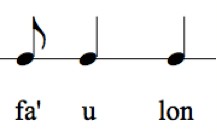
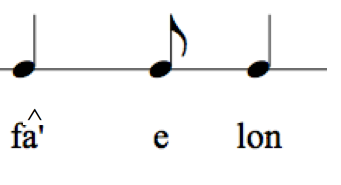
It is from this template of short and long vowel sounds that all rhythmic devices are derived. As mentioned earlier, the radif contains a number of rhythmic pieces called zarbi or tekkes which have no modal stability and adopt the dastgah in which they are played. These pieces are built from different organisations of the mnemonics depicted above and present the range of rhythms used in performance. These zarbi or tekkes are used in much the same way as gushehs such that they form the basis for limited improvisation by the performer. For example, the tekke kereshme is constructed from the mnemonic ![]() . This short/long vowel combination produces the rhythm notated below:
. This short/long vowel combination produces the rhythm notated below:
Below is a notated version of kershme and audio file clearing depicting this rhythm from the first complete bar:
Considering the role of poetry presents a particular challenge to my project since neither myself nor my performer are native Farsi speakers and therefore we will not be able to understand the meaning of the words or accurately replicate the rhythmic patterns they produce. Furthermore, I am uneasy about using the work of medieval mystics Rumi, Saadi and Hafez in a Western context. As Winegar points out, in recent years there has been a strong Western predilection for Middle Eastern art that circumvents contemporary Islam. The selective promotion and display of Middle Eastern art and music in the West favours work that either de-contextualises Islam, focusing instead on its ancient ‘golden age’, or erases it, concentrating instead on notions of spiritualism and mysticism. Since a discourse of art as humanism continues to underwrite the consumption of art and music in the West, the implication here is that contemporary Islam is anti-humanist since it is only works that overlook this element that are given ‘art’ status in the West[55]. This has been particularly evidenced in the plethora of Sufi concerts performed in recent years which advocate a “peaceful, apolitical Islam as an explicit counter to radical Islam”[56]. Presenting Sufi mysticism as the opposite of contemporary Islam only serves to bolster the notion that Islam today is uniformly radical and oppressive. Moreover, the promotion of Sufi art and music over works dealing with contemporary Islam reproduces the construction that no art is produced in the contemporary Middle East due to a tyrannical Islam that stifles creativity. It could also be said that employing the poetry of medieval mystic poets runs dangerously close to reproducing the Orientalist notion of a distant East that is permanently frozen in the past.
It is not only the context of the poets that I find difficult to reproduce in a Western context but also their gender. All three of the poets that play a key role in Iranian classical music are men. Furthermore, all singers performing solo in concerts in Iran are men also. Since the revolution, the public presence of women in Iran has been modified in accordance with perceived laws of chastity, tolerance and modesty. In terms of music, this has meant it has been illegal for a woman to sing solo in a performance outside of her home since 1979. Over the past three decades women have creatively tried to overcome this ban through a number of practices which include singing in choruses, performing in private houses or singing in unison as part of a duo or trio (called ‘hamkhani’)[57]. Interestingly, women are permitted to sing when it is deemed they are doing so in a ‘changed voice’ which normally refers to singing in a childlike manner (most notably observed in advertisements) or singing in a melismatic ‘soprano’ style.
Thus it would seem that the problematic aspects of women’s solo voices are neutralised when they are either infantilised or prevented from making linguistic sense. As Bosma suggests, producing non-verbal vocal sounds is an important stereotypical role for women in opera which is tied to associations of the female voice as irrational[58]. In the context of Iranian music, female expression is limited by both banning solo performance and rendering any limited utterances childlike or unintelligible. When this is considered alongside the fact that all lyrical material is written by men, it seems that Iranian women are effectively prohibited from the most important roles in Iranian classical music and specifically from the act of discursive self-expression in public[59]. In relation to my own composition, and as a British-Iranian woman, my aim is to draw on the role of poetry in Iranian classical music and represent it in such a way that it neither pacifies nor decontextualises contemporary Islam and also allows for female expression.
6. Conclusion
To conclude, in this essay I have considered three key areas of Iranian classical music which can be defined as firstly the practice of improvisation, secondly the presence of microtonal fluctuations and thirdly the role of poetry. I have explored how these features become intertwined with Orientalist discourses when considered through the paradigm of Western musical cultures such that improvisation is considered primitive and unintellectual, microtonal fluctuations are tied to an untamed Eastern Otherness and the role of poetry has the effect of pacifying both contemporary Islam and the voices of women. Through my accompanying composition I aim to explore and challenge these constructions which can be generally defined as part of an Orientalist programme while at the same time producing an innovative composition that considers my own complex relationship to Iranian culture. My resulting composition is for multi-tracked female voice and I will now reflect on a number of features of this work.
Firstly, since improvisation in Iranian classical music is based on a lifetime of implicit rule learning, I would suggest it is somewhat similar to the act of native language acquisition. A speech act within a particular language is necessarily constrained by both rules of grammar and syntax and socio-cultural norms of usage. Only when a speaker has a near complete understanding of these rules are they able to creatively use it in a way that makes sense to all other speakers. This is normally achieved subconsciously through exposure from a very young age with no explicit knowledge of the rules at play. Similarly, improvisation in Iranian classical music requires an extensive knowledge of the rules and norms governing the repertoire as a whole and often requires a lifetime of practice. It is only when the radif has been learned and memorised in its entirety that students are permitted to use it creatively in their own performances and practices that deviate too far from these norms are deemed incorrect. Against this backdrop and drawing on the performer’s lifetime knowledge of English, I will use the patterns and practices of speech as the context for improvisation in my composition. In this way I can encourage the performer to be creative and yet remain within strict, implicit limits of grammar, syntax and normative usage. To achieve this I will present the performer with a selection of word cards from which they will construct a piece of prose that will form the narrative basis of the piece. Through this process the performer will use their implicit knowledge of the English language to create a coherent text while at the same time building a unique path that draws on their own repertoire built up over many years. In this way I hope to reflect the processes of improvisation found in Iranian classical music in which strict rules of normative usage constrain what is still a unique creative process.
Secondly, since conventional Western notation both silences and problematises microtonal fluctuations I will reject this form of representation entirely. Thus I will not construct a score in the normal sense but will use the prose constructed by the performer as a guide. In this way my piece will reflect the context of Iranian classical music in which the only notated aspect of the performance is the words of the poem – the musical sounds are not depicted in any way. Furthermore I will avoid a sense of Western tonality by giving no specific directions with regards to pitch. I will encourage the performer to harness the natural microtonal inflections of their voice through emotional and situational directions. For example, the performer will be directed to recite (speaking/singing/whispering etc.) certain sections of the prose using particular emotive directions as a guide. These directions will be drawn from translations of twelve gusheh which have emotional traits as their names such that each sentence of prose is assigned to a particular gusheh mood. In this way my composition will reflect another key practice of Iranian classical music wherein each gusheh forms a self-contained melodic or rhythmic unit which are weaved together through performance.
Thirdly, since poetry plays such a central role in Iranian classical music, I will construct my word cards from an English translation of the 1965 poem Let us believe in the beginning of the cold season by Forough Farrokhzad[60]. Farrokhzad is widely credited as the most important female Iranian poet of the 20th century and her work deals with a range of issues including love, lust, sin, religion and loneliness. By using her work as the source for my piece I aim to present a narrative voice that is both female and contemporary. Farrokhzad deals with the contradictions and controversies of contemporary Islam in her work while at the same time representing the complex position of women in Iranian society since her work has been at times banned by the current regime. I will use her work in translation so that it has narrative meaning to myself and my performer and also so that I may use the natural syllabic movements of the words as the basis for rhythmic movement in the piece. Further, in order to explore the role of women in Iranian classical music, my piece will be performed by a single female vocalist who will be multi-tracked so as to sound like three versions of herself. Here I will dramatically represent the practice of ‘hamkhani’ – by which two or three women sing in unison as a means of circumventing the ban on solo female performances in Iran. Through simultaneously reproducing and subverting this technique I will consider the role of female creativity both in Iranian classical music and wider Iranian society.
Below is an audio file of the composition that resulted from this research, entitled Come condolences with time passed: I will love and give up. Click here to see a pdf explaining the devising process used to produce this piece.
Come condolences with time passed: I will love and give up is a personal reflection on the techniques and practices of Iranian classical music. I feel the devising process, through which the performer built the text from word cards of the poetry of Forough Farrokhzad, was very succesful. The prose that resulted from this technique was lyrical, beautiful and deeply personal to myself, the performer and the moment of creation. Although I did not show the performer any of Farrokhzad’s poetry, the prose that resulted strongly resembled the wistful, lonely quality of her work while at the same time being a totally unique object. Moreover the esoteric, mystical nature of the prose inadvertently echoed some of the work of medieval mystic poets Saadi, Hafez and Rumi while still remaining a contemporary and feminine voice. The role of the feminine voice is key to this composition which, through the use of multi-tracking, dramatically represents the process of ‘hamkhani’ and thus considers the role of women in Iranian classical music. Stereo spatialisation allows the voice of one performer to sound like a group of women in conversation while the juxtaposition of spoken and sung sections suggests the contrast of an inner and outer voice. Thus this piece considers the role of women in contemporary public discourse considering the relative absence of women’s voices in both Iran and the UK.
Throughout the devising process I encouraged a rejection of Western notions of fixed tonality. However despite my attempts to encourage the performer to work outside of a Western system of intervals, the piece retains some level of tonal stabillity. Such consanance could be seen as either a sequence of chance events or the consequence of both myself and my performer’s location within the context of Western contemporary art music. Since I gave the performer no directions in terms of melodic movement or tonality, it is perhaps unsurprising that they deferred to the system of tonality in which they feel most comfortable. However at particular junctures in the piece, specifically where spoken words seem to transform into sung phrases, the presence of microtonal inflections is more obvious. In these moments a sense of tonality is disrupted as the listener is encouraged to imagine and engage with the microtones that lie in between speaking and singing. Thus future research should perhaps explore the boundaries between performed and non-performed noises, considering the borders between sounds we consider musicallly communicative and those we label as socially productive.
Fundamentally this composition attempts a non-Orientalist take on Iranian musical practices. By considering the socio-cultural relevance of musical techniques as well as the cognitive processes of performers, I have endeavoured to integrate some aspects of dastgah into my own practice as a composer. Crucially, this research paper represents only a first investigation into this complex subject considering the dynamics of representation and cultural exchange in a global market. This is a notion of particular relevance in the contemporary musical context which, through a discourse of postmodernism, is more interconnected than ever before and dominated by a rhetoric of hybridity and exchange.
BACK TO POST[1] Edward Said, Orientalism (London: Penguin, 2003).
BACK TO POST[2] Ibid., 4.
BACK TO POST[3] Ralph. P. Locke Orientalism at http://www.grovemusic.com
BACK TO POST[4] Ibid,.
BACK TO POST[5] See Frith, 2000.
BACK TO POST[6] Steven Feld, ‘A Sweet Lullaby for World Music’ in Public Culture 12 (1) (2000) 147.
BACK TO POST[7] David Hesmondhalgh, ‘Digital Sampling and Cultural Inequality’ in Social Legal Studies 15 (1) (2006)
BACK TO POST[8] Ashwani Sharma, ‘Sounds Oriental: The (Im)possibility of Theorizing Asian Musical Cultures’ in Dis-orienting Rhythms: The Politics of the New Asian Dance Music eds. Sanjay Sharma, John Hutnyk and Ashwani Sharma (London: Zed, 1996) 11.
BACK TO POST[9] For critiques of postcolonialism see Dirlik, 1994; Shohat, 1992; McClintock, 1992.
BACK TO POST[10] Georgina Born & David Hesmondhalgh, Western Music and its Others (Berkeley: University of California Press, 2000) 6.
BACK TO POST[11] http://www.guardian.co.uk/world/2012/apr/30/ehud-barak-iran-nuclear-programme?INTCMP=SRCH
BACK TO POST[12] Laudan Nooshin, ‘The Song of the Nightingale: Processes of Improvisation in Dastgah Segah (Iranian Classical Music)’ in British Journal of Ethnomusicology, 7 (1998) 72.
BACK TO POST[13] Ibid., 71.
BACK TO POST[14] Rambod Sodayf, A Century of Avaz: An Anthology of the Contemporary Art of Singing in Persian Classical Music, CD (Mahoor), 2003.
BACK TO POST[15] Shahram Nazeri, Journey to Beyond ‘An Khattat’. CD, Soroush, 6 260209 101852, 2000.
BACK TO POST[16] Adib Khansari, Persian Vocal Music: Songs of Adib Khansari (Mahoor Records), 2005.
BACK TO POST[17] Ibid,.
BACK TO POST[18] Ella Zonis, ‘Contemporary Art Music in Persia’ in The Musical Quarterly 51 (4) (1965) 641.
BACK TO POST[19] Hossein Alizadeh, Radif of Mirza Abdollah according to Nur-Ali Borumand, prod. Naser Farhudi. CD, Mahoor Institute of Culture and Art (Mahoor Records), 6 260608 001326, 1992.
BACK TO POST[20] Ibid,.
BACK TO POST[21] Hormoz Farhat, The Dastgah Concept in Persian Music, (Cambridge: CUP, 1990) 109.
BACK TO POST[22] Michel Foucault, Power/Knowledge: Selected Interviews and Other Writing 1972-1977 ed. Colin Gordon, trans. Gordon et al. (New York: Pantheon, 1980).
BACK TO POST[23] Susan Bordo, ‘Anorexia Nervosa: Psychopathology as the Crystallisation of Culture’ in Feminism and Foucault: Reflections on Resistance ed. Irene Diamond & Lee Quinby (Northeastern University Press, 1988) 101.
BACK TO POST[24] Laudan Nooshin, ‘Improvisation as “Other”, Creativity, Knowledge and Power: The Case of Iranian Classical Music’ in Journal of the Royal Musical Association 128 (2) (2003).
BACK TO POST[25] Robert Moore ‘The Decline of Improvisation in Western Art Music: An Interpretation of Change’ in International Review of the Aesthetics and Sociology of Music 23 (1) (1992) 63.
BACK TO POST[26] Nooshin, ‘Improvisation as “Other”’ 245 ff.
BACK TO POST[27] H. C. Colles ‘Extemporisation or Improvisation’ Grove’s Dictionary of Music and Musicians (5th Edition, London, 1954) 991.
BACK TO POST[28] Nooshin, ‘Improvisation as “Other”’ 248.
BACK TO POST[29] Ibid., 244.
BACK TO POST[30] Ibid., 244.
BACK TO POST[31] Laudan Nooshin, ‘Nightingales and Mullahs’ in World Music, The Rough Guide: Africa, Europe and the Middle East ed. Simon Broughton et al. (London: The Rough Guides, 1999) 358.
BACK TO POST[32] Nooshin, ‘Song of the Nightingale’ 73.
BACK TO POST[33] Ibid., 91.
BACK TO POST[34] Hossein Alizadeh, Radif of Mirza Abdollah, 1992.
BACK TO POST[35] Adib Khansari, Persian Vocal Music, 2005.
BACK TO POST[36] Hamid Shahsavan, Resistance of Wine (Mahoor Records), forthcoming.
BACK TO POST[37] Bruno Nettl, ‘Thought on Improvisation: A Comparative Approach’ in The Musical Quarterly 60, 14.
BACK TO POST[38] Nooshin, ‘Song of the Nightingale’, 91.
BACK TO POST[39] Hossein Alizadeh, Radif of Mirza Abdollah, 1992.
BACK TO POST[40] Farhat, The Dastgah Concept in Persian Music’ 9.
BACK TO POST[41] Ibid., 9.
BACK TO POST[42] Jan Herlinger, ‘Fractional Divisions of the Whole Tone’ in Music Theory Spectrum 3 (Spring, 1981) 75.
BACK TO POST[43] Farhat, The Dastgah Concept in Persian Music, 10.
BACK TO POST[44] Hossein Alizadeh, Radif of Mirza Abdollah, 1992.
BACK TO POST[45] Ibid., 15.
BACK TO POST[46] Ibid., 16.
BACK TO POST[47] Philip Tagg, ‘Analyzing Popular Music: Theory, Method and Practice’ in Popular Music, 2 (1982) 28-32 Accessed via: http://www.tagg.org/articles/xpdfs/pm2anal.pdf
BACK TO POST[48] Many composers in the course of 20th century have reacted against the narrowness of conventional notation in Western art music of which key figures include John Cage, Cornelius Cardew and Carlheinz Stockhausen. Crucially, however, these attempts have not managed to unseat conventional notation but have merely widened the scope of what is now accepted as a form of representing music.
BACK TO POST[49] Elizabeth Eva Leach, ‘Gendering the Semitone, Sexing the Leading Tone: Fourteenth-Century Music Theory and the Directed Progression’ in Music Theory Spectrum 28 (1) (2006) 5-6.
BACK TO POST[50] Susan McClary, Carmen (Cambridge, CUP, 1992).
BACK TO POST[51] Jonathan Pieslak, Sound Targets: American Soldiers and Music in the Iraq War (Bloomington, IN.: Indiana University Press, 2009).
BACK TO POST[52] Dr Hossein Elahe-Ghomshei ‘Correspondences Between Poetic Meters and Rhythms in Persian Classical Music’ presented at The Beauty of Iranian Classical and Contemporary Music at SOAS, London 31/03/12.
BACK TO POST[53] Nooshin, ‘Nightingales and Mullahs’, 355.
BACK TO POST[54] Gen’ici Tsuge, ‘Rhythmic Aspects of the Avaz in Persian Music’ in Ethnomusicology 14 (2) (1970) 206.
BACK TO POST[55] Jessica Winegar, ‘The Humanity Game: Art, Islam and the War on Terror’ in Anthropological Quarterly 81 (3) (2008).
BACK TO POST[56] Ibid., 15.
BACK TO POST[57] Parmis Mozafari, ‘Iranian Female Performers’ presented as part of The Beauty of Iranian Classical and Contemporary Music in SOAS, London (31/03/12).
BACK TO POST[58] http://www.hannahbosma.nl/paperFTM4.html
BACK TO POST[59] Although women are permitted to perform as instrumentalists, the majority of classical musicians in Iran continue to be men.
BACK TO POST[60] Accessed via http://www.forughfarrokhzad.org/collectedworks/collectedworks4.htm on 16/05/12.
Bibliography
Text resources
Bordo, Susan. ‘Anorexia Nervosa: Psychopathology as the Crystallisation of Culture’ in Feminism and Foucault: Reflections on Resistance, ed. Irene Diamond & Lee Quinby. Northeastern University Press, 1988.
Born, Georgina & David Hesmondhalgh Western Music and its Others. Berkeley: University of California Press, 2000.
Colles, Henry. ‘Extemporisation or Improvisation’ in Grove’s Dictionary of Music and Musicians. 5th Edition: London, 1954, 991-993.
Dirlik, Arif. ‘The Postcolonial Aura: Third World Criticism in the Age of Global Capitalism’ in Critical Inquiry, 20/2 (1992), 328-356.
During, Jean. Le Repertoire-modele de la Musique Iranienne: Radif de setar de Mirza ‘Abdollah. Tehran: Soroush Press. 1995.
Elahe-Ghomshei, Hossein. ‘Correspondences Between Poetic Meters and Rhythms in Persian Classical Music’ The Beauty of Iranian Classical and Contemporary Music at SOAS. (30/03/12).
Farhat, Hormoz. The Dastgah Concept in Persian Music. Cambridge: CUP, 1990.
Feld, Steven. ‘A Sweet Lullaby for World Music’ Public Culture, 12/1 (2000), 145-171.
Foucault, Michel. Power/Knowledge: Selected Interviews and Other Writings 1972-1977 ed. C. Gordon. New York: Pantheon, 1980.
Herlinger, Jan. (1981) ‘Fractional Divisions of the Whole Tone’ in Music Theory Spectrum 3 (1981), 74-83.
Hesmondhalgh, David ‘Digital Sampling and Cultural Inequality’ in Social Legal Studies, 15/1 (2006), 53-75.
Frith, Simon. ‘The Discourse of World Music’ in Western Music and its Others eds. Georgina Born & David Hesmondhalgh. Berkeley: University of California Press, 2000. 305-322.
Kant, Immanuel. Critique of Judgment. Translated by J.H. Bernard. London: Collier Macmillan, 1951 [1790]
Leach, Elizabeth Eva. ‘Gendering the Semitone, Sexing the Leading Tone: Fourteenth-Century Music Theory and the Directed Progression’ in Music Theory Spectrum 28/1 (2006), 1-21.
Locke, Ralph P. Orientalism at http://www.grovemusic.com Accessed 16/05/12
McClary, Susan. Carmen. Cambridge: CUP, 1992.
McClintock, Anne. ‘The Myth of Progress: Pitfalls of the Term Post-colonialism’ in Social Text, 31/32 (1992), 84-98.
Moore, Robert. ‘The Decline of Improvisation in Western Art Music: An Interpretation of Change’ in International Review of the Aesthetics and Sociology of Music, 23/1 (1992), 61-84.
Mozafari, Parmis ‘Iranian Female Performers’ in The Beauty of Iranian Classical and Contemporary Music. SOAS. (30/03/12)
Nettl, Bruno. ‘Thoughts on Improvisation: A Comparative Approach’ in The Musical Quarterly 60 (1974), 1-19.
Nooshin, Laudan. ‘The Song of the Nightingale: Processes of Improvisation in Dastgah Segah (Iranian Classical Music)’ in British Journal of Ethnomusicology, 7 (1998), 69-116.
________ ‘Nightingales and Mullahs’ in ed. Simon Broughton et al. World Music, The Rough Guide: Africa, Europe and the Middle East. London: The Rough Guides, 1999, 355-359.
________ ‘Improvisation as “Other”, Creativity, Knowledge and Power: The Case of Iranian Classical Music’ in Journal of the Royal Musical Association, 128/2 (2003), 242-296.
Said, Edward. Orientalism. London: Penguin, 2003.
Sharma, Ashwani. ‘Sounds Oriental: The (Im)possibility of Theorizing Asian Musical Cultures’ in eds. Sanjay Sharma, John Hutnyk and Ashwani Sharma Dis-orienting Rhythms: The Politics of the New Asian Dance Music. London: Zed, 2006, 1-11.
Shohat, Ella. ‘Notes On the Postcolonial’ in Social Text, 31/32 (1992), 99-113.
Tagg, Phillip. (1982) ‘Analyzing Popular Music: Theory, Method and Practice’ in Popular Music, 2 (1982), 28-32. Accessed via http://www.tagg.org/articles/xpdfs/pm2anal.pdf on 16/05/12.
Pieslak, Jonathan. Sound Targets: American Soldiers and Music in the Iraq War. Bloomington, IN.: Indiana University Press, 2009.
Tsuge, Gen’ichi. ‘Rhythmic Aspects of the Avaz in Persian Music’ in Ethnomusicology 14/2 (1970), 205-227.
Winegar, Jessica. ‘The Humanity Game: Art, Islam and the War on Terror’ in Anthropological Quarterly, 81/3 (2008), 651-681.
Zonis, Ella. ‘Contemporary Art Music in Persia’ in The Musical Quarterly, 51/4 (1965), 636-648.
Sound resources
Alizadeh, Hossein. Radif of Mirza Abdollah according to Nur-Ali Borumand, prod. Naser Farhudi. CD, Mahoor Institute of Culture and Art, Mahoor Records, 1992.
Khansari, Adib. Persian Vocal Music: Songs of Adib Khansari, Mahoor Records, 2005.
Nazeri, Shahram. Journey to Beyond ‘An Khattat’. CD, Soroush, 2000.
Nazeri, Shahram. Saghi Nameh II, prod. Raziedin Artimani. CD
Shahsavan, Hamid. Resistance of Wine, Mahoor Records, forthcoming.
Various Artists. A Century of Avaz: An Anthology, Mahoor Records, 2007.

